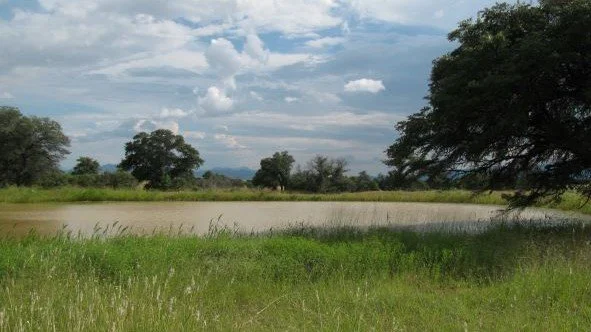Sonoran Tiger Salamander Monitoring
Walking up to the stock pond in Arizona’s San Rafael Valley, you might not expect that its brown water harbors a salamander that’s endangered with extinction. The pond is murky and surrounded by cows, cow pies, and mud. Yet when Dr. Tom Jones of the Arizona Game and Fish Department and his crew pull a heavy seine net through the water, the mesh of the net yields four rare Sonoran tiger salamanders.
Sonoran tiger salamanders (Ambystoma tigrinum stebbinsi) were federally listed as endangered in 1987 and are limited to the San Rafael Valley, the foothills of several nearby mountain ranges, and adjacent areas in Mexico. To survive and breed, they need year-round standing water, such as the natural spring-fed marshes known as cienegas in which they were once found. Today most of those cienegas are gone, and the ponds created by ranchers for their livestock are the most common breeding habitat for the salamanders.
Like other amphibians, Sonoran tiger salamanders have a fascinating life history. Adults lay strings of gelatinous eggs in the water, which hatch into gilled larvae. As the salamanders mature, they take one of two pathways: they either metamorphose into colorful, terrestrial adults without gills, or they remain in their larval form – gilled, fully aquatic, but sexually mature and able to breed in their natal ponds.
The salamanders Jones and his crew pull up today are the latter variety of adult, called branchiates or paedomorphs. They are mud-colored like the water and a happy sight for the biologists, evidence that the endangered species is successfully breeding in this pond. But finding them was hard work.
““It’s expensive to send a crew down here to seine for salamanders. It takes a long time - in a day, we would probably do five or six sites, tops, and there are many dozens of sites we need to sample.””
Enter eDNA. Jones has collaborated with eDNA researchers Dr. Caren Goldberg and Dr. Katherine Strickler at Washington State University, who compared detection rates and cost efficiency of seine netting and eDNA sampling. After working out an optimal sampling design, the team found Sonoran tiger salamander eDNA at every site at which they caught salamanders, and at three additional sites where no salamanders were found. And because eDNA sampling is so efficient in these ponds, the cost of surveying with eDNA was much lower than the cost of seine surveys.
The success of eDNA for Sonoran tiger salamander monitoring is appealing to Jones, who leads AZGFD’s Reptiles and Amphibians Program. “With eDNA, we could monitor these sites much more quickly and efficiently. If the question we’re asking is: are the salamanders there, or are they not, then eDNA will answer that for us.”
“If certain techniques with eDNA can be refined, we might be able to tell something about densities of salamanders as well,” Jones said. “But I think that’s in the future.”



